A special thank you to Blue Man Dog for allowing us to reprint their excellent information to help you with your new dog! You can always reachout to Mia at Blue Man Dog for Shelter consultations and Behavior training at: info@bluemandog.org Paws Up! to Mia and team!
New Dog Help
by Blue Man Dog
Adopted a dog?! As exciting as it is to bring your new dog home, the absolute best time to set your dog and yourself up for long term success starts from the moment the dog arrives.
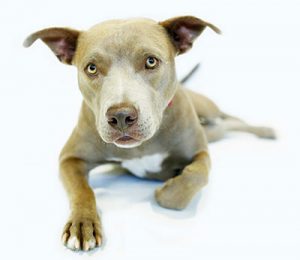 The first week is stressful, for the both the dog and usually for the human. But once you are past the first week, things settle a bit, and after a month or two you will be set in your new routines with your dog.
The first week is stressful, for the both the dog and usually for the human. But once you are past the first week, things settle a bit, and after a month or two you will be set in your new routines with your dog.
You need to be mindful that everything is new to the dog – including yourself – and they don’t immediately understand that you adopted them to give them a great life. Even if the dog seems fine, newly adopted dogs are almost always confused and sometimes even scared. If you think about it from their point of view, someone picks you up and takes you to a strange place with unknown sights and smells, how would you feel? Most likely a little stressed and uneasy.
 Dogs are like kids, so the most important thing is to have a very simple routine at first, including clear rules and boundaries. Make sure you establish these from day one, so that the dog can settle in and understand their new life: what time to wake up, what time to sleep, where to sleep, where in the house they can and cannot go, and that you will leave the house sometimes and they will be home alone. Setting rules is just as important as being loving, so set some basic house rules for your dog to follow from day 1, as it will help them understand what is expected of them in their new life.
Dogs are like kids, so the most important thing is to have a very simple routine at first, including clear rules and boundaries. Make sure you establish these from day one, so that the dog can settle in and understand their new life: what time to wake up, what time to sleep, where to sleep, where in the house they can and cannot go, and that you will leave the house sometimes and they will be home alone. Setting rules is just as important as being loving, so set some basic house rules for your dog to follow from day 1, as it will help them understand what is expected of them in their new life.
We always say the first month is all about getting used to everything. After this period of gaining trust and learning what is expected, life becomes normal and relaxed for you and your new dog!
One of the most important things is to practice leaving the dog alone in his new home. Leave the house for an hour twice on the first day with the dog in their crate. On day two, you can increase the time to a couple of hours. This way the dog will learn that when you leave the house this is perfectly normal, you will return, and understand that being home alone is just fine!
It is imperative that you do this from the very first day. If you spend 24/7 with the dog at first, the dog will learn that this is the norm, and will not understand being left alone when you have to go to work a few days later. This is how dogs develop separation anxiety and bark/whine while you are out. Stress or even panic is not a good state of mind for the dog, so please help them be successful and calm in being home alone by practicing this from the very beginning.
“I wish I had known that from the beginning!”
This page goes over many helpful hints for how to be successful & build a great foundation with your new dog. This is based on experience, and has been tried and tested with hundreds of dogs and adopters. It is well worth reading carefully.
( Also check out Blue Man Dog's Behavior Problems FAQ )
The Most Important Things To Purchase
- COLLAR- a martingale collar is recommended as your dog can’t slip out of it, so it is very safe.
- LEASH- a sturdy 6 foot leash with a strong clasp.
- CRATE- for the home, wire crates are the best, as the dog can see everything going on around them. Plus, they fold down flat and are easy to store when you don’t need them.
- ID TAG- the most important thing to have on your dog’s collar at all times! Even if your dog is micro-chipped, the ID tag is more easily visible and anyone can call you should your dog get away by accident. Always keep the collar with ID tag on your dog, even at home. You can purchase an ID tag with your phone number on it at most pet stores for less than $10
- FOOD and BOWLS – good quality, grain-free dry food (kibble) will start you off just fine, and sturdy dishes for food and water.
Remember to register your dog’s microchip number in your name and with your contact information, and also license your dog with the city you live in.
CRATE
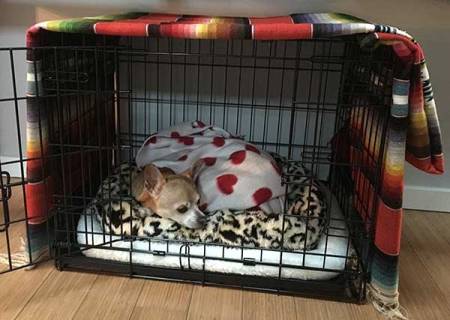 The crate is helpful in many ways and it will become a substitute den for your dog. It’s a place where he/she can feel safe, comfortable and allows for peaceful rest.
The crate is helpful in many ways and it will become a substitute den for your dog. It’s a place where he/she can feel safe, comfortable and allows for peaceful rest.
Once your dog has learned the new routines and is doing well, you do not have to crate the dog any longer. Many adult dogs will not need much crating since they are usually house-trained and also not likely to tear up your home. That said, many dogs love their crate and are happy to have it as their bed and place of retreat for the rest of their lives.
On the first day, make sure to crate your dog and leave home, even if just for an hour. If you hang out all weekend with your new dog and then go to work on Monday, your dog won’t understand why he/she is being left alone after all that time together and may develop separation anxiety. Therefore it’s important for your dog’s well-being that you practice leaving them alone from day one.
Crate your dog at night for at least 3-4 weeks. Crating helps with house training. First thing in the morning, take the dog straight from the crate to outside so they can go to the bathroom. Crating your dog at night in the beginning also helps him/her learn your schedule (when to sleep and when to be up).
Crating is also a great way to keep puppies or very young dogs safe when you are away, but no more than 4 hours at a time. If you work full days, make sure you have a friend or dog walker take the dog out for a good walk in the middle of the day. Another option in the beginning is doggy day care, as the dog is getting used to its new home and lifestyle.
House Training
 Many dogs coming from a kennel situation are not likely house trained, or will need a refresher course. A good rule of thumb is to take dog outside first thing in the morning to go to the bathroom, then again within an hour after a meal. Puppies and young dogs need to go 10 min after finishing a meal. Then they need will need a toilet break midday and again in the early evening and another before bed.
Many dogs coming from a kennel situation are not likely house trained, or will need a refresher course. A good rule of thumb is to take dog outside first thing in the morning to go to the bathroom, then again within an hour after a meal. Puppies and young dogs need to go 10 min after finishing a meal. Then they need will need a toilet break midday and again in the early evening and another before bed.
If your dog has an accident inside, DO NOT punish the dog! A dog cannot learn a lesson after the fact, they do not understand why you are upset. Some people think that the dog understands the punishment because they look “ashamed” when you are yelling at them pointing at the area where they have gone, but dogs can not make that connection. They may look “ashamed” but actually that look is because they are totally confused and scared by your strange behavior. Just clean it up.
If you catch them in the act, then you can make a big noise, like a handclap and loud NO! to interrupt them. Then – quickly! – put leash on or lift them up and go straight outside without being mad. Once they finish their business outside, praise them with your voice.
Food
There are so many different dog food brands, it’s confusing to determine which is the right one for your dog. You don’t have the get the most expensive but do avoid the cheapest.
You do want to avoid food with corn and by-products. Adding fish oil capsules or a tablespoon of coconut oil to the dog’s daily meals is a great (and tasty) addition to maintain good skin and a shiny coat.
You can feed your dog in his/her crate; this makes the crate a more positive place to be. Feeding should happen every morning and evening. We suggest feeding 2/3 of the daily portion in the morning and 1/3 in the evening. Getting a smaller portion of food in the evening makes your dog less likely to have accidents at night. About an hour after the evening feeding, your dog will need to be walked or go outside before staying in for the night.
The feeding schedule can be adjusted to fit your schedule also. If you’re going to be leaving for a long day at work, don’t give your dog a big portion of food and expect him to hold it in all day. In that case, switch and feed small portion in morning and larger in evening. Be mindful and figure out what works best for you and your dog.
Rules and Boundaries
Make certain you set rules and boundaries for your dog to follow. Rules are important for both dogs and humans! Small or large, young or adult, it’s all the same… don’t begin by spoiling your dog unless you want to live with a brat for many years to come!
If your dog is displaying unwanted behavior, disagree! You need to let the dog know, in a very clear way which is understandable to him/her, that this behavior is not allowed. For example, you can use a firm “NO” or a shaker can (a can with a few rocks or pennies inside). A few simple rules go a long way to having harmony in your home!
Shy Dog
 If your dog appears to be a little nervous or shy, it’s best to ignore this behavior. And more importantly, do not reward it by petting the dog and talking in a baby voice! You may feel like these things will comfort the dog, but exactly the opposite happens: you are rewarding that insecure state of mind and teaching your dog to remain nervous/shy.
If your dog appears to be a little nervous or shy, it’s best to ignore this behavior. And more importantly, do not reward it by petting the dog and talking in a baby voice! You may feel like these things will comfort the dog, but exactly the opposite happens: you are rewarding that insecure state of mind and teaching your dog to remain nervous/shy.
Allow your new dog to get comfortable with you and his/her new home. Let him/her come to you to be petted, not the other way around. If you are pushy with your affection, your dog may get nervous and become even more shy (“too much too soon”).
If you are adopting a dog you already know is shy, play hard to get. Try to ignore your dog and allow him/her to get used to his/her new environment. When you are calm, not pushy with your affection, your dog will begin to relax, and then want your attention!.
Take it slow and make progress in steps, not all at once. Give them a little pet when dog comes up, but then walk away or take your hand away. The dog is more likely to follow and want more petting since you did not overwhelm them, than if you pet them so much that they feel they have to move away. If you play hard to get, you will become interesting to the dog and enable them to build trust with you.
Usually it’s a rather quick process if you follow this technique. Make certain that you have all other new people meeting your dog do the exact same thing. This helps the dog to learn to trust and enjoy people as unthreatening, rather than remaining in a fearful state of mind because they all want to touch too much too soon.
Balconies and Fences
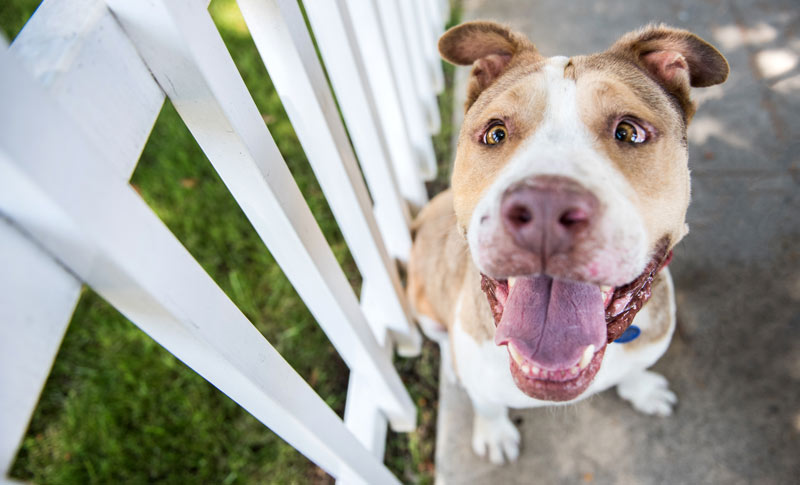 Check your balcony or fence if you have one. A small dog can easily get through balcony fencing unless it’s solid. Dogs can get out of the smallest spaces in a fence especially when they are new and not used to their home. Awareness of this reduces the chance of unwanted escapes, or (potentially worse!) dogs getting stuck, struggling, and injuring or strangling themselves.
Check your balcony or fence if you have one. A small dog can easily get through balcony fencing unless it’s solid. Dogs can get out of the smallest spaces in a fence especially when they are new and not used to their home. Awareness of this reduces the chance of unwanted escapes, or (potentially worse!) dogs getting stuck, struggling, and injuring or strangling themselves.
Remember we easily get blinded by familiarity and ignore what we see every day. Before you even let your dog out, walk around your fence, check your gates that they don’t have a space of just a few inches – you would be surprised how small of a space a dog can squeeze through. If in ANY doubt, block it, make it even more safe than you think you need.
Some dogs will also dig to get out, so if you have soil by your fence, you’ll need to block the area. Either put down stones or bricks so they extend a few inches past and under the fence on the other side, with the large side toward your yard. That way the dog can’t dig at the fence to get out.
For the first month, do not leave your dog unattended in a yard or balcony. Make sure you know how your dog behaves and be extra aware that if you leave the house, your dog may panic and will do everything possible to come with you, and that can have a tragic outcome. Until you know your dog is used to being left alone, it is always safer to lock dogs inside the house or even crated when you leave your home.
Recent Surgery
If your dog has been recently spayed or neutered, make sure to check the incision site for swelling daily and read the instructions provided by the clinic. Check the date of surgery and DO NOT BATHE FOR TWO WEEKS after surgery date!
Bathing
 Short-haired dogs may not need regular bathing at all. Keeping their bedding clean is usually enough. If your dog has a coat that does need bathing or grooming, it is not recommended to shampoo your dog more often than once a month, at the very most! Shampooing dries out their skin and removes the natural oils that keep their coat soft and dirt/smell resistant. Instead, you can rinse with only water or brush them to keep the coat nice and shiny!
Short-haired dogs may not need regular bathing at all. Keeping their bedding clean is usually enough. If your dog has a coat that does need bathing or grooming, it is not recommended to shampoo your dog more often than once a month, at the very most! Shampooing dries out their skin and removes the natural oils that keep their coat soft and dirt/smell resistant. Instead, you can rinse with only water or brush them to keep the coat nice and shiny!
Leash Walking
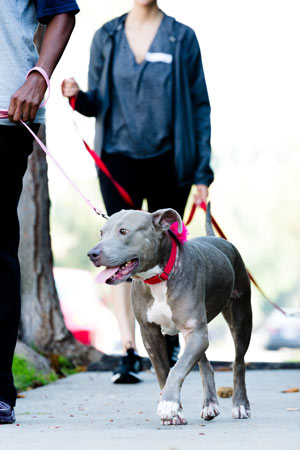 Walk your dog with a purpose. Dogs should not be pulling on the leash. It is true that small dogs are easier to control, so if you have a big dog this is particularly important, however, that doesn’t mean small dogs shouldn’t also walk nicely and politely and respect you and everyone else on their walks.
Walk your dog with a purpose. Dogs should not be pulling on the leash. It is true that small dogs are easier to control, so if you have a big dog this is particularly important, however, that doesn’t mean small dogs shouldn’t also walk nicely and politely and respect you and everyone else on their walks.
To get started on the right path, don’t let your dog sniff and have the nose to the ground constantly and “read the newspaper”. It distracts them and means they don’t pay attention to you. The walk is not for the dog to be out doing its own thing, but for you two to be out together, enjoying a joint activity. However, dogs like to sniff, so at two or three moments of YOUR choosing, you should deliberately stop your walk for your dog to sniff a little. You decide when to stop, allow your dog to sniff, and when to start walking again.
The dog needs to learn to pay attention to you as the leader and take your direction while out on a walk. Dogs are not born to understand walking on leash, just like we are not born knowing how to drive a car. It is not natural for them at all, so it takes a lot of practice and direction. Be patient, but consistent: you walk first, your dog behind. This sets the basic mindset of who is the leader and who is the follower. Once your dog learns to follow you, you will have much fewer problems, and can share a great time on your walks and adventures together!
Toys and Play
 At first, avoid too many toys and play. Kong or Nylabone type toys are good for chewing needs and can keep a dog occupied, that is what you want. But beware of many other types of toys, as they can create more problems than you want. We never recommend fluffy squeaky toys that look like small animals. Besides the risk of choking on the squeaker, this type of play increases prey-drive in your dog. Remember that the squeak your dog loves is the same sound as a small animal dying!
At first, avoid too many toys and play. Kong or Nylabone type toys are good for chewing needs and can keep a dog occupied, that is what you want. But beware of many other types of toys, as they can create more problems than you want. We never recommend fluffy squeaky toys that look like small animals. Besides the risk of choking on the squeaker, this type of play increases prey-drive in your dog. Remember that the squeak your dog loves is the same sound as a small animal dying!
Playing with your dog can easily make your dog stressed and overly excited. Tug of war is never a good game. For the dog, it’s not a game but rather a fight over the object. Mentally you are asking your dog to challenge you. Even if you “win” at the end of the game, what you are teaching your dog by encouraging tug-of-war is that it is ok for him to keep challenging the winner – that he should challenge the alpha. Tug of war also teaches dogs to bite towards human hands. Similarly, do not wrestle or “mess” with your dog physically: all it does is teach the dog that being physical, assertive, jumping, and grabbing a person is ok, since you are teaching them to do so. The dog cannot differentiate when this activity is “play” and when it is not, and if they do this with a child (or another human of any age), thinking that is the proper way to play, it can lead to incidents where people think the dog is misbehaving or displaying aggression, when in reality, it is what the dog has been taught to do by you! We strongly recommend avoiding those types of activities, especially with powerful breeds and high-energy dogs.
If your dog is energetic, throwing items for them to chase (“fetch”) may sound like a good idea for them to burn off energy, but it’s the opposite: as your dog chases and hunts the object, this excited state of mind is increased, as well as the dog’s energy level. You are basically asking your dog to behave crazy and run around in a manic way, chasing after small things that move. You can come up with with appropriate games for you and your dog once you know your dog better and they have settled in.
Socialize
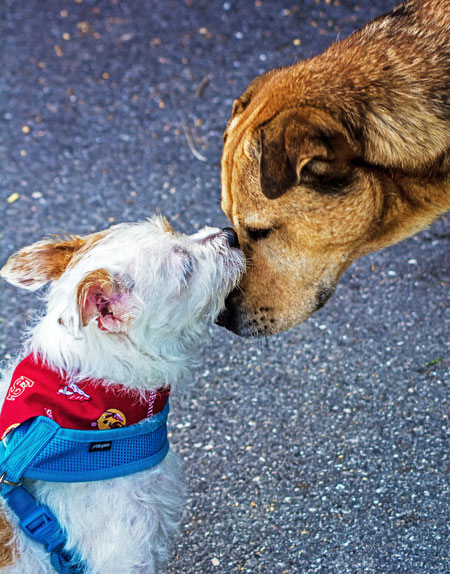 A dog will need to be socialized, with people and other dogs! Do not isolate your dog. This is IMPERATIVE if you want them to be friendly and able to cope in the company of other people and dogs.
A dog will need to be socialized, with people and other dogs! Do not isolate your dog. This is IMPERATIVE if you want them to be friendly and able to cope in the company of other people and dogs.
Dog parks are a great place for dogs to socialize, BUT you must be responsible about whether your dog is suitable for the dog park. First of all, we do not recommend going there until after your first few months together – you first need to bond and get to know your dog. The dog park is for well-socialized dogs, so before you know your own dog well, be mindful of the other people and dogs at the park. Don’t risk bringing in a dog in that you don’t know yet.
In the first few months, find people with friendly dogs and arrange play-dates or walks. This is an ideal way to learn about your dog’s social skills. Doggy daycare once or twice a week is also a good option.
When meeting other dogs, remember that nose-to-nose greetings are a sign of tension for dogs. A proper, relaxed greeting is when the dogs sniff each other from the side and rear. A very good way to introduce new dogs is to walk them together in the same direction while letting the dogs sniff each other after a little while as you walk. If a friend with a dog comes to visit you, take the dogs for a walk first and walk for as long as it takes for the dogs to appear less interested in each other. Assuming all goes well on the walk, you can then lead them both into the house together. You can also leave their leashes on, dragging on the floor so you can easily pick up the leash if needed.
If after some months you decide to take your dog to the dog park, follow the rules. Never put a small dog into the big dog section! Even if your own dog is good with dogs of all sizes, you must remember that other dogs may not be: some big dogs are wonderful with other big dogs but their prey-drive is triggered by small dogs.
We strongly recommend not taking a pit bull type dog to the park until you’ve had her/him for a long time and know the dog is rock solid with other dogs. The reason is that, should something happen and your dog is involved, the pit bull always gets the blame. Be a responsible pit bull owner, avoid dog parks and other off-leash areas unless you have a dog with an extremely solid temperament and social skills, even in situations where other dogs are misbehaving.
At the dog park, you must behave like a parent at a playground: be there, but allow your dog to socialize with other dogs (and not hang around or play with you). The point of taking your dog to the dog park is for him/her to learn how to play with the other “kids” and improve their social skills.
Multiple Dog Home
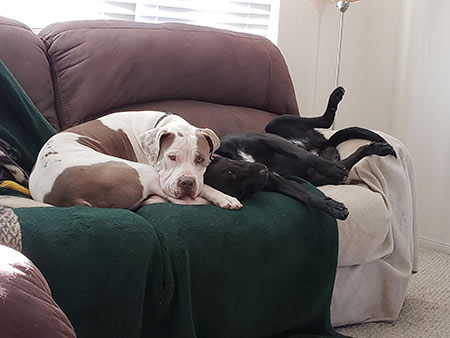 If you’re adding a dog to a home with existing dog(s), the best way to find a good match is to bring your dog to the first meeting with the dog who’s caught your attention.
If you’re adding a dog to a home with existing dog(s), the best way to find a good match is to bring your dog to the first meeting with the dog who’s caught your attention.
Every dog has it’s own taste when it comes to picking a playmate and future sibling, so it’s important to see if they appear to be a good match.
When you bring the new dog into their new home, it is best to take it slow. Use the crate to rotate dogs, one in and one out, walk the dogs together, and only have them out together for short time periods – always supervised. Remember, the new dog has to settle in with EVERYTHING so it’s a lot to take in and learn. And the existing dog has to make a big adjustment as well, so be understanding.
It’s wise to limit human affection towards the dogs at first, including your existing dog(s). Doing this allows the dogs to bond to each other, without starting a competition for human attention. Otherwise, jealousy will arise along with all those problems.
Don’t treat the new dog like a stepchild; you must be fair to both. Also be aware that your original dog may become a brat at times, challenging this new situation, and he/she will need to be told “no.” Rules should be the same for both dogs, whether the rules are new or well-established.
Let the dogs establish their own relationship at their own pace. Don’t be upset if they do not play or snuggle together from day 1. There is no need to encourage them to do so. Friendships take time and you can’t force it.
At mealtime, feed dogs separately, one in crate, one outside OR put the leashes on both dogs. Even the most mellow, finicky eaters can turn back to wild animals over protecting their food! Food guarding is a normal instinct for a dog, but you will want to avoid any and all potential incidents, so separate them. Over time you may be able to figure out what works best for your pack at feeding time, but take it slow. Also, remove all bones and toys you may have for your established dog(s), as they can easily become another source for guarding and conflict, which you want to avoid. As time goes by, you will get to know the dynamic between the dogs and may have toys out again if you desire.
Take the entire process slow, nice and easy: rules & boundaries first, allow the dogs to bond at their own pace, and remove objects that can lead to arguments.
Dogs and Cats
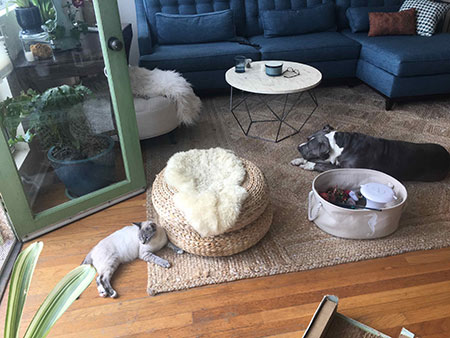 Yes, it is possible to have dogs and cats living in the same home together, but remember that they are very different species with different quirks. As always, start with the structure of humans first, but the cat comes in second, and the dog needs to know from minute one that he/she is last! We’re not saying that dogs are less important, but rather acknowledging the reality that dogs are more willing and able to learn new rules, whereas most cats have no desire to change their lives for anyone.
Yes, it is possible to have dogs and cats living in the same home together, but remember that they are very different species with different quirks. As always, start with the structure of humans first, but the cat comes in second, and the dog needs to know from minute one that he/she is last! We’re not saying that dogs are less important, but rather acknowledging the reality that dogs are more willing and able to learn new rules, whereas most cats have no desire to change their lives for anyone.
Start by taking precautions for your cat’s safety, as most dogs have trouble not following their instinct of chasing “small fluffies.” Make certain your cat has many safe places to escape from the dog, under the bed, on a table or dresser, and the top of a tall cat tree.
At the first sign of a dog in the house, your cat will probably run for cover. As the cat runs, the dog will definitely notice (and may want to chase), and this is the best moment to begin teaching your dog – with the biggest, strongest “NO” you can manage – that the cat is off-limits. If the cat won’t leave their hiding room for a while, bring food and a litterbox to them and keep the dog away. Put up a barrier to remind the dog he/she’s not allowed in the cat’s space. The barrier could never protect a determined dog from breaking it down, but the visual presence will give the dog time to slow down and remember the rules, which you should verbally reinforce. Stand on the cat’s side of the barrier, wait for the dog to see the cat, and give another firm “NO.” Practice this exercise often to continue teaching the dog that the cat is always off-limits, but the “no’s” can get smaller and gentler as your dog learns.
Many dogs learn so well that they become afraid of the cat, and usually that was the cat’s intention the entire time! After learning to accept one another, some dogs and cats can become great friends, and others are perfectly happy just co-existing.
If your dream is to see them cuddle, adopt a kitten – they will likely be the only feline happy to accept a dog’s affection.
Dogs and Kids
When children and dogs share the same home, we cannot stress enough the necessity for parents teach their own and other children how to behave around dogs! Children need to learn to be gentle and calm around animals, and to be respectful — and the dog will need to learn to be respectful of children also.
Dogs are not born being uncomfortable with kids, but bad experiences with children can make dogs uncomfortable and unsure. The way children tend to move (excited, fast, rambunctious, loud and with unpredictable gestures) is very confusing and potentially scary to dogs, so make sure to teach your kids the proper way to behave around a dog, and allow the dog to get used to the kids.
A key lesson is reminding kids to “let sleeping dogs lie”, as in; they must leave the dog to rest and sleep without disturbance. If the dog retreats to his bed, the children should respect that. Also, kids should never disturb the dog while he/she is eating. And, of course, always supervise the children when with the dog.
Here is a great article about dog and kids to learn more: foundanimals.org/preventing-dog-bites
Children are the future. Please educate your children to take proper care of their pets, also as they get older and slower. A family member is a family member for life. Teach them the importance of spaying and neutering pets, so that we can begin to decrease our current, massive overpopulation of unwanted dogs and cats. If the next generation learns to treat pets responsibly, we can make a huge difference and make our society a better place.
This information was provided by Blue Man Dog. For more free training advice and handouts, or in-person sessions in the LA area, visit bluemandog.org
